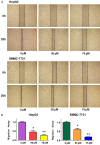Diosgenin increased DDX3 expression in hepatocellular carcinoma
- PMID: 30662610
- PMCID: PMC6291714
Diosgenin increased DDX3 expression in hepatocellular carcinoma
Abstract
Liver cancer, one of the most common malignant tumors occurred worldwide, has emerged as a main health trouble and accounts for leading cancer-related death. Diosgenin is provided as an important material in the pharmaceutical industry, and is used to manage various medical troubles such as cancer because of its multiple bioactivities. DEAD box polypeptide 3 (DDX3) is involved in cancer biogenesis and modulates cancer progression. However, the role of DDX3 in human hepatocellular carcinoma (HCC) has not been fully understood. In the present study, we investigated the anti-tumor effects of diosgenin on HCC cells and whether DDX3 is involved in its antitumor activity. We observed that diosgenin dramatically inhibited cell proliferation, triggered apoptotic cell death, induced G2/M phase arrest, suppressed cell migration and invasion abilities. Moreover, the expression of DDX3 was measured and the results showed that DDX3 was significantly up-regulated upon diosgenin exposure. All together, our data indicated that diosgenin shows a cytotoxic effect on HCC cells and has potential therapeutic values for HCC patients.
Keywords: DDX3; diosgenin; hepatocellular carcinoma; invasion; proliferation.
Conflict of interest statement
None.
Figures






Similar articles
-
DDX3, a DEAD box RNA helicase, is deregulated in hepatitis virus-associated hepatocellular carcinoma and is involved in cell growth control.Oncogene. 2006 Mar 30;25(14):1991-2003. doi: 10.1038/sj.onc.1209239. Oncogene. 2006. PMID: 16301996
-
DDX3 suppresses hepatocellular carcinoma progression through modulating the secretion and composition of exosome.Am J Cancer Res. 2023 May 15;13(5):1744-1765. eCollection 2023. Am J Cancer Res. 2023. PMID: 37293175 Free PMC article.
-
Rottlerin upregulates DDX3 expression in hepatocellular carcinoma.Biochem Biophys Res Commun. 2018 Jan 1;495(1):1503-1509. doi: 10.1016/j.bbrc.2017.11.198. Epub 2017 Dec 2. Biochem Biophys Res Commun. 2018. PMID: 29203243
-
Multifunctional DDX3: dual roles in various cancer development and its related signaling pathways.Am J Cancer Res. 2016 Jan 15;6(2):387-402. eCollection 2016. Am J Cancer Res. 2016. PMID: 27186411 Free PMC article. Review.
-
DDX3, a potential target for cancer treatment.Mol Cancer. 2015 Nov 5;14:188. doi: 10.1186/s12943-015-0461-7. Mol Cancer. 2015. PMID: 26541825 Free PMC article. Review.
Cited by
-
The Emerging Role of Stress Granules in Hepatocellular Carcinoma.Int J Mol Sci. 2021 Aug 30;22(17):9428. doi: 10.3390/ijms22179428. Int J Mol Sci. 2021. PMID: 34502337 Free PMC article. Review.
-
Induction of G2/M Phase Arrest by Diosgenin via Activation of Chk1 Kinase and Cdc25C Regulatory Pathways to Promote Apoptosis in Human Breast Cancer Cells.Int J Mol Sci. 2019 Dec 25;21(1):172. doi: 10.3390/ijms21010172. Int J Mol Sci. 2019. PMID: 31881805 Free PMC article.
-
Diosgenin potentiates the anticancer effect of doxorubicin and volasertib via regulating polo-like kinase 1 and triggering apoptosis in hepatocellular carcinoma cells.Naunyn Schmiedebergs Arch Pharmacol. 2024 Jul;397(7):4883-4894. doi: 10.1007/s00210-023-02894-8. Epub 2024 Jan 2. Naunyn Schmiedebergs Arch Pharmacol. 2024. PMID: 38165424
-
Preparation of Diosgenin-Functionalized Gold Nanoparticles: From Synthesis to Antitumor Activities.Int J Mol Sci. 2025 Jan 27;26(3):1088. doi: 10.3390/ijms26031088. Int J Mol Sci. 2025. PMID: 39940856 Free PMC article.
-
An Updated Review of Molecular Mechanisms Implicated with the Anticancer Potential of Diosgenin and Its Nanoformulations.Drug Des Devel Ther. 2025 Mar 24;19:2205-2227. doi: 10.2147/DDDT.S502322. eCollection 2025. Drug Des Devel Ther. 2025. PMID: 40160969 Free PMC article. Review.
References
-
- Burgett AW, Poulsen TB, Wangkanont K, Anderson DR, Kikuchi C, Shimada K, Okubo S, Fortner KC, Mimaki Y, Kuroda M, Murphy JP, Schwalb DJ, Petrella EC, Cornella-Taracido I, Schirle M, Tallarico JA, Shair MD. Natural products reveal cancer cell dependence on oxysterol-binding proteins. Nat Chem Biol. 2011;7:639–647. - PMC - PubMed
-
- Raju J, Mehta R. Cancer chemopreventive and therapeutic effects of diosgenin, a food saponin. Nutr Cancer. 2009;61:27–35. - PubMed
-
- Huang B, Du D, Zhang R, Wu X, Xing Z, He Y, Huang W. Synthesis, characterization and biological studies of diosgenyl analogues. Bioorg Med Chem Lett. 2012;22:7330–7334. - PubMed
-
- Chen Y, Tang YM, Yu SL, Han YW, Kou JP, Liu BL, Yu BY. Advances in the pharmacological activities and mechanisms of diosgenin. Chin J Nat Med. 2015;13:578–587. - PubMed
LinkOut - more resources
Full Text Sources
